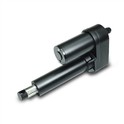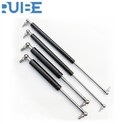Hey there! As a supplier of lockable gas springs, I know how annoying it can be when these handy devices start making a racket. Noise from lockable gas springs can be a real pain, especially in applications where quiet operation is key, like medical beds, massage chairs, or sofas. In this blog post, I'm gonna share some practical tips on how you can reduce the noise of a lockable gas spring.
Understanding the Causes of Noise
Before we dive into the solutions, it's important to understand what causes the noise in the first place. There are several factors that can contribute to a noisy lockable gas spring:
- Friction: One of the most common causes of noise is friction between the piston rod and the cylinder wall. Over time, the lubricant inside the gas spring can wear off, leading to increased friction and noise.
- Vibration: If the gas spring is not properly installed or if it's being used in a high-vibration environment, it can start to rattle and make noise.
- Internal Components: Loose or damaged internal components, such as the valve or the seal, can also cause noise.
Tips to Reduce Noise
Now that we know what causes the noise, let's look at some ways to reduce it:
1. Lubrication
- Choose the Right Lubricant: Using the right lubricant is crucial for reducing friction and noise. Look for a lubricant that is specifically designed for gas springs and that can withstand high pressures and temperatures.
- Apply Lubricant Regularly: Make sure to apply lubricant to the piston rod and the cylinder wall regularly. This will help to keep the components moving smoothly and reduce friction.
2. Proper Installation
- Follow the Manufacturer's Instructions: When installing a lockable gas spring, it's important to follow the manufacturer's instructions carefully. This will ensure that the gas spring is installed correctly and that it's properly aligned.
- Use the Right Mounting Hardware: Using the right mounting hardware is also important for reducing noise. Make sure to use the mounting brackets and bolts that are recommended by the manufacturer.
3. Isolation
- Use Vibration Isolators: If the gas spring is being used in a high-vibration environment, consider using vibration isolators to reduce the noise. Vibration isolators can help to absorb the vibrations and prevent them from being transmitted to the surrounding components.
- Mount the Gas Spring on a Soft Surface: Mounting the gas spring on a soft surface, such as rubber or foam, can also help to reduce the noise. The soft surface will absorb the vibrations and prevent them from being transmitted to the floor or the wall.
4. Maintenance
- Inspect the Gas Spring Regularly: Regularly inspecting the gas spring for signs of wear and tear is important for reducing noise. Look for any cracks, leaks, or damage to the components, and replace them if necessary.
- Replace Worn Components: If the internal components of the gas spring are worn or damaged, replace them as soon as possible. This will help to prevent further damage and reduce the noise.
Applications and Noise Reduction
Let's take a look at some specific applications where lockable gas springs are commonly used and how to reduce the noise in each case:
Medical Beds
Medical beds require quiet operation to ensure the comfort of the patients. To reduce the noise of a lockable gas spring in a medical bed, you can:
- Choose a High-Quality Gas Spring: Look for a gas spring that is specifically designed for medical beds and that has a low noise level.
- Lubricate the Gas Spring Regularly: Make sure to lubricate the gas spring regularly to reduce friction and noise.
- Use Vibration Isolators: Consider using vibration isolators to reduce the noise caused by vibrations.
You can find more information about Gas Struts for Medical Bed.
Massage Chairs
Massage chairs also require quiet operation to provide a relaxing experience for the users. To reduce the noise of a lockable gas spring in a massage chair, you can:


- Select a Quiet Gas Spring: Choose a gas spring that is designed to operate quietly.
- Properly Install the Gas Spring: Make sure to install the gas spring correctly and to use the right mounting hardware.
- Inspect and Maintain the Gas Spring Regularly: Regularly inspect the gas spring for any signs of wear and tear, and replace any damaged components.
Check out Massage Chair Lockable Gas Spring for more details.
Sofas
Sofas are often used in living rooms and other areas where quiet operation is important. To reduce the noise of a lockable gas spring in a sofa, you can:
- Opt for a Low-Noise Gas Spring: Look for a gas spring that has a low noise level.
- Ensure Proper Alignment: Make sure that the gas spring is properly aligned and that it's not rubbing against any other components.
- Lubricate the Gas Spring Occasionally: Apply lubricant to the gas spring occasionally to keep it moving smoothly.
Learn more about Lockable Gas Spring for Sofa.
Conclusion
Reducing the noise of a lockable gas spring is not rocket science. By following the tips outlined in this blog post, you can significantly reduce the noise and ensure that your gas spring operates smoothly and quietly. Remember, regular maintenance and proper installation are key to keeping your gas spring in good condition.
If you're in the market for high-quality lockable gas springs or if you have any questions about reducing noise, feel free to reach out to us. We're here to help you find the right solution for your needs.
References
- Manufacturer's manuals for lockable gas springs
- Industry best practices for gas spring maintenance and installation






